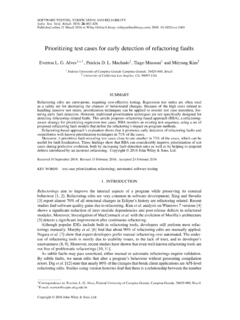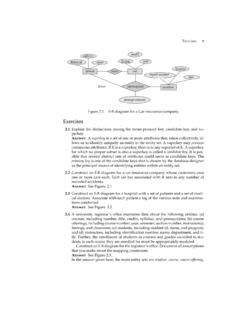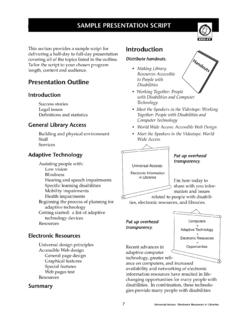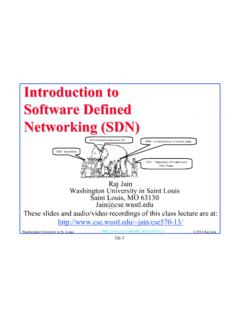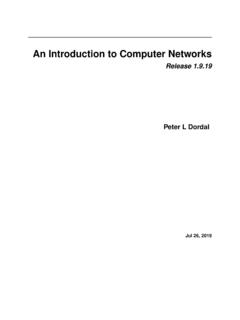Transcription of Peer-to-peer networking with BitTorrent
1 Peer-to-peer networking with BitTorrent Jahn Arne Johnsen Lars Erik Karlsen Sebj rn S ther Birkeland Department of Telematics, NTNU - December 2005. Abstract Peer-to-peer networking has in recent years received a lot of attention due to the ongoing battle with the music and movie industry. Despite many beliefs it is not a new concept but, in its simplest form, has existed for over four decades and can be traced back to the original implementation of the Internet. BitTorrent is a distributed Peer-to-peer system which, it is stated, has the potential to change the landscape of broadcast media and file distribution. It uses a symmetric (tit-for-tat) transferring model in an attempt to reach Pareto efficiency. Its protocol employs various mechanisms and algorithms in a continuous effort to try to ensure that there are no other variations in the network arrangement which will make every downloader at least as well off and at least one downloader strictly better off.
2 In its original implementation, BitTorrent base its operation around the concept of a torrent file, a centralized tracker and an associated swarm of peers. The centralized tracker provides the different entities with an address list over available peers. Later improvements tries to eave the weakness of a single point of failure (the tracker), by implementing a new distributed tracker solution. Amongst BitTorrent s most prominent future uses are applications which combine BitTorrent and RSS (Really Simple Syndication), with the powerful ability to transform the Internet into the world s largest TiVo. Table of contents 1 2 Peer-to-peer Peer-to-peer NETWORK 3 introduction TO THE HISTORY OF AREAS OF 5 4 THE BitTorrent The Piece Selection Resource Concluding IMPORTANT Bulk traffic Decentralized 5 THE FUTURE OF 6 7 1 introduction Currently software using Peer-to-peer networking solutions are becoming increasingly popular.
3 Compared to the more common server-client solution, a Peer-to-peer approach has several advantages including increased robustness and resource providing, such as bandwidth, storage space and computing power, by peers. One area where robustness and utilization of resources is important is file distribution, especially of large files. An example of a Peer-to-peer solution that has proven to be an efficient and reliable alternative to the classical server-client solution is BitTorrent . This essay will focus on BitTorrent as a Peer-to-peer solution and explain the architecture and concepts that make up BitTorrent . The self-configuring parts will be highlighted as this essay is a part of the course TTM3 Self Configuring Systems. A brief look into area of use, history and the future of BitTorrent is also presented and discussed. Part one of this essay gives a brief introduction to Peer-to-peer networks in general.
4 Part two focuses on BitTorrent . 1 2 Peer-to-peer networking The emergence of Peer-to-peer computing signifies a revolution in connectivity that will be as profound to the Internet of the future as Mosaic was to the Web of the past - Patrick Gelsinger, Vice President and CTO, Intel Corp. Although Peer-to-peer networking has received a lot of attention recently due to the ongoing battle with the music and movie industry, it is not a new concept. In its simplest definition, Peer-to-peer is described as [23]: A communications model in which each party has the same capabilities and either party can initiate a communication session [23] This means that conceptually, Peer-to-peer computing is an alternative to the traditional client / server architecture where there typically is a single (or small cluster) server and many clients (figure 1).
5 Figure 1 Sticking with the previous definition, the concept of Peer-to-peer can be traced back to the 1960 s when the early implementation of the Internet (ARPANET) was a Peer-to-peer network in which all its peers were equals. However, this definition can be fitted into many scenarios. The Domain Name System (DNS) is a good example of a blend between the traditional Peer-to-peer networking and a hierarchical model of information ownership. A more precise definition is stated in [17] as: A distributed network architecture may be called a Peer-to-peer (P-to-P, P2P,..) network, if the participants share a part of their own (hardware) resources (processing power, storage capacity, network link capacity, printers,..). These shared resources are necessary to provide the Service and content offered by the network ( file sharing or shared workspaces for collaboration).
6 They are accessible by other peers directly, without passing intermediary entities. The participants of such a network are thus resource (Service and content) providers as well as resource (Service and content) requestors (Servant-concept). [17] As there exists many forms of Peer-to-peer networks, both with and without some with a form of central entity, this definition was further refined in [17]. This refinement introduced a classification of Peer-to-peer networks as either pure (Figure 2) or hybrid (Figure 3). This was done so one is be able to distinguish between Peer-to-peer networks with or without the previously mentioned central entity. 2 Peer-to-peer network topologies Pure Peer-to-peer The pure Peer-to-peer concept is a network in which the peers themselves are the only entities allowed within.
7 Or as stated in [17]: A distributed network architecture has to be classified as a Pure Peer-to-peer network, if it is firstly a Peer-to-peer network according to Definition 1 and secondly if any single, arbitrary chosen Terminal Entity can be removed from the network without having the network suffering any loss of network service. This is concept is showed in Figure 2. Here we can clearly see that only what seem to be equal peers are present in the network. All are interconnected which means that any peer can be removed, without this having any fatal consequences on the network, there is no single point of failure. Figure 2 Hybrid Peer-to-peer Figure 3 Different from a pure Peer-to-peer concept, where only the peers themselves were allowed in the network, a hybrid network will always include some sort of central entity.
8 This is shown in Figure 3. In [17] the hybrid Peer-to-peer concept is defined as: A distributed network architecture has to be classified as a Hybrid Peer-to-peer network, if it is firstly a Peer-to-peer network according to Definition 1 and secondly a central entity is necessary to provide parts of the offered network services. As Figure 3 shows, there are now hub nodes in the network which connects different networks. If one of these nodes go down, the center hub node of Figure 3, some parts of the network are suddenly separated. This makes the Hybrid Peer-to-peer network more vulnerable to attacks or failure. 3 3 introduction to BitTorrent BitTorrent is a technology/protocol which makes the distribution of files, especially large files, easier and less bandwidth consuming for the publisher.
9 This is accomplished by utilizing the upload capacity of the peers that are downloading a file. A considerably increase in downloaders will only result in a modest increase in the load on the publisher hosting the file. Figure 4 The basic flow of the BitTorrent protocol. The illustration in Figure 4 shows the basic flow of BitTorrent . The figure on the left shows a client-server approach to download. The peers download from the server simultaneous. If we assume the upload capacity of the server is the same as the download capacity of a peer , the time for the download to finish will be two times the time if only one peer where downloading from the server. The figure on the right shows an approach similar to BitTorrent . By splitting the file and send one part to each peer , and let the peers download the part they are missing from each other, both download time and load on the server is reduced.
10 Of course, the BitTorrent protocol is much more sophisticated than this simple example, but this shows the basic idea. The history of BitTorrent BitTorrent is by far the most popular Peer-to-peer programs ever. Analysis shows that it accounts for about 35% of all Internet traffic [22]. How did it become so popular, and what makes it so special? By the end of the 90 s, Bram Cohen got tired of jumping between dotcoms which never released any product before they went bankrupt. He decided to develop something on his own, and got inspiration from his last job. This company s idea was to keep a file safe and secure by breaking it into small pieces, encrypt the pieces and store them in different locations. Bram realized that the concept of breaking a file into smaller chunks also could be used in file sharing.






